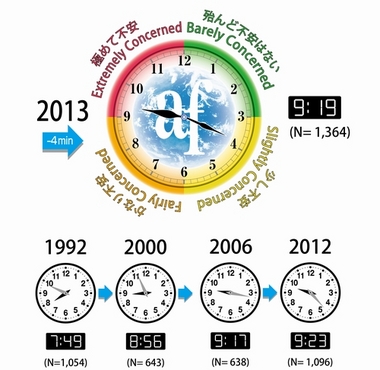November 1, 2013
The Asahi Glass Foundation 2013 Survey Shows Environmental Doomsday Clock Set at 9:19
Keywords: Climate Change Ecosystems / Biodiversity Manufacturing industry
The Asahi Glass Foundation, a Japanese organization that strives to support research in the fields of natural/social science and technology and the tackling of global environmental issues, conducts an annual survey on the sense of crisis felt by respondents about human survival threatened by the deterioration of the global environment. People indicate their concern level using the hands on the 12-hour Environmental Doomsday Clock created by the foundation. The 2013 survey results were released in September 2013 based on answers from about 1,400 respondents. For respondents in Japan, the Clock was set back nine minutes from the previous year to 9:05, but for overseas respondents, the clock advanced by three minutes to 9:30.
Overall, the average time on the Environmental Doomsday Clock for all respondents was 9:19, indicating approximately the same overall level of crisis felt as last year. For North America, the Asian region (except Japan), Eastern Europe, and the former Soviet Union, however, the regional times on the clock were pushed forward compared to last year.
Of the environmental conditions of concern used by respondents to specify the time on the Clock, "climate change" and "biodiversity" were the most frequently named issues, with respondents giving their concern about "biodiversity" the most advanced clock time, suggesting a heightened sense of crisis.
Since the 1992 Earth Summit held in Rio de Janeiro, Brazil, the foundation has annually surveyed experts worldwide who are knowledgeable about environmental issues through its "Questionnaire on Environmental Problems and the Survival of Humankind" and released the survey results in a report. Junko Edahiro, chief executive of Japan for Sustainability, is one of the respondents of the questionnaire survey in 2013.
Related
"JFS Newsletter"
- Shaping Japan's Energy toward 2050 Participating in the Round Table for Studying Energy Situations
- Implementation of the Paris Climate Agreement: A Report on Japan's Round Table for Studying Energy Situations
- Auto Sales Industry Cooperates to Tackle Social Responsibility: Examples from Yamagata, Japan
- Yokohama FC: Leader in Eco-Activities through Football-Related Carbon Offset
Related
"Popular Articles"
- Large Ozone Hole Observed Again in 2011
- Japan's Pro Baseball Teams Start Eco-Project to Cut Energy Use by 6%
- Manufacturer Saving Energy by Growing Vertical Gardens on Factory Walls
- Sony Draws Up 'Road to Zero' Plan for Zero Environmental Footprint
- Tokyo Announces Innovative 10-Year Strategy against Climate Change



